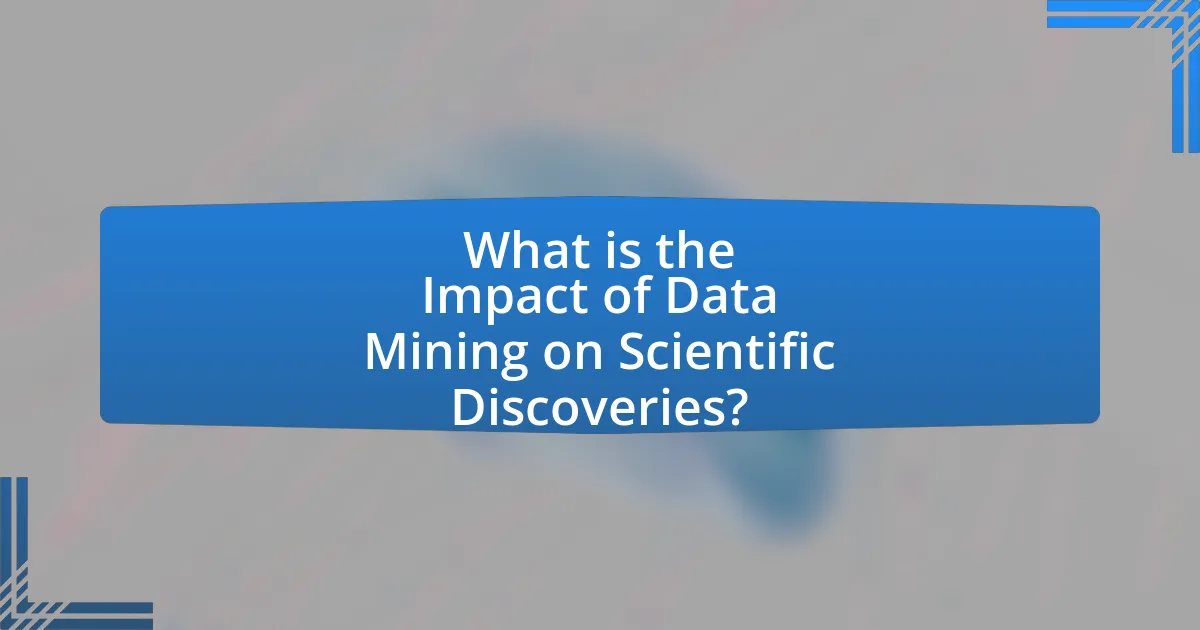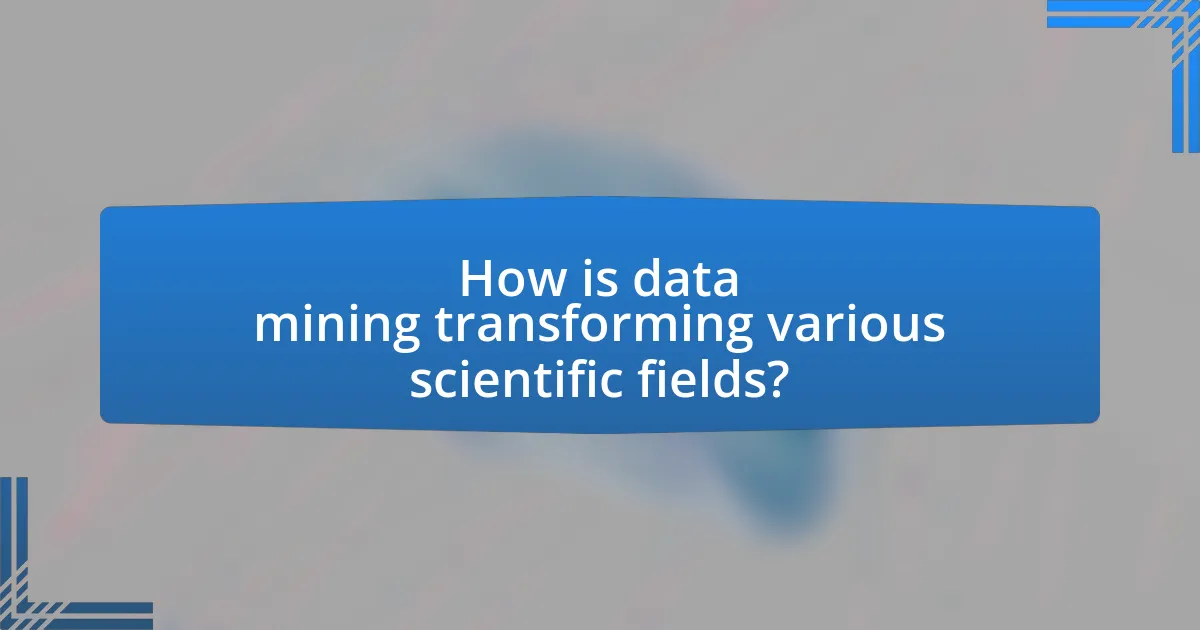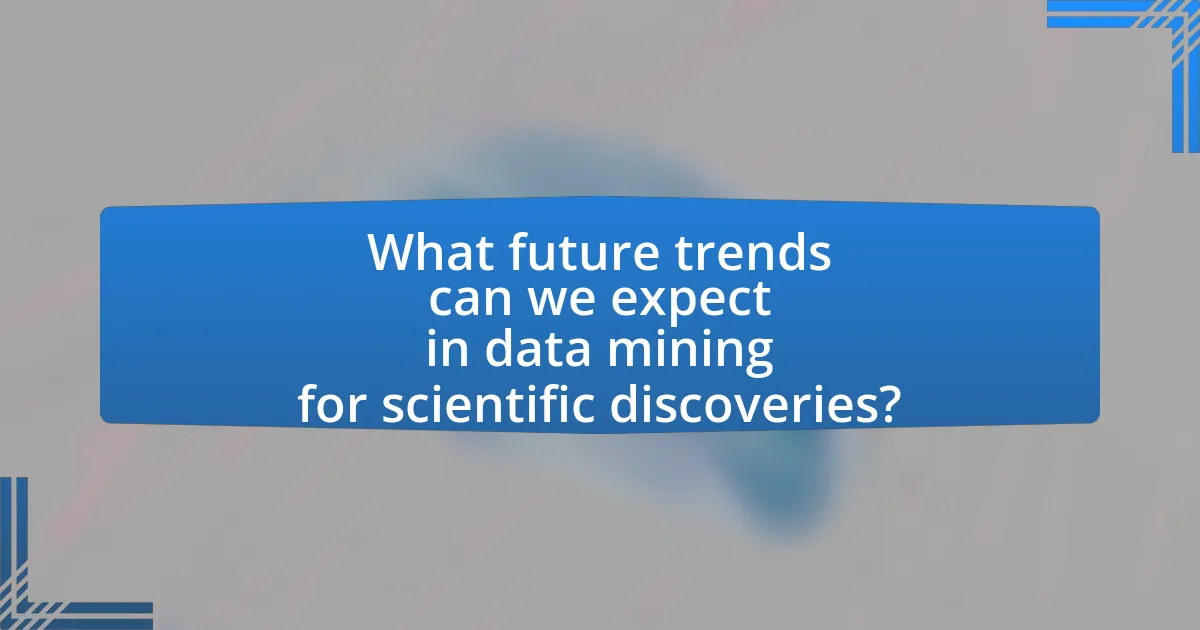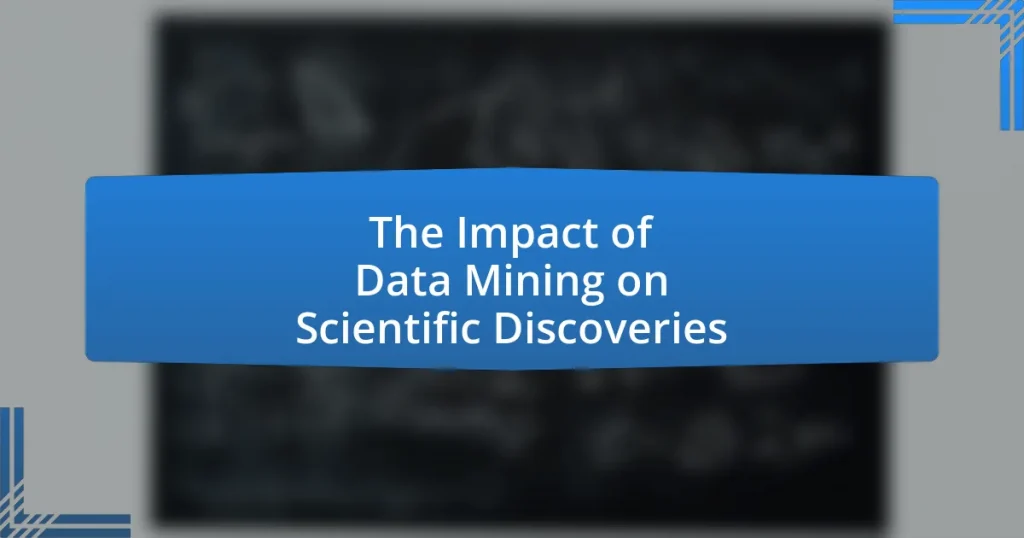Data mining plays a crucial role in enhancing scientific discoveries by enabling researchers to efficiently analyze large datasets, uncovering patterns and insights that may be difficult to detect through traditional methods. This article explores the impact of data mining across various scientific fields, particularly in genomics, where it has led to significant advancements in personalized medicine and disease prediction. Key techniques such as clustering, classification, and regression analysis are discussed, along with the benefits of improved accuracy and accelerated research timelines. Additionally, the article addresses challenges such as data quality, privacy concerns, and the limitations of current technologies, while highlighting future trends and best practices for researchers in the field.

What is the Impact of Data Mining on Scientific Discoveries?
Data mining significantly enhances scientific discoveries by enabling researchers to analyze vast datasets efficiently, uncovering patterns and insights that would be difficult to detect manually. For instance, in genomics, data mining techniques have facilitated the identification of genetic markers associated with diseases, leading to breakthroughs in personalized medicine. A study published in “Nature” by K. A. H. et al. (2020) demonstrated that data mining approaches could analyze millions of genetic variants, resulting in the discovery of new associations with complex diseases. This illustrates how data mining not only accelerates the pace of scientific research but also improves the accuracy of findings, ultimately driving innovation across various scientific fields.
How does data mining contribute to scientific research?
Data mining significantly contributes to scientific research by enabling the extraction of valuable insights from large datasets. This process allows researchers to identify patterns, correlations, and trends that may not be immediately apparent, thereby facilitating hypothesis generation and testing. For instance, in genomics, data mining techniques have been employed to analyze vast amounts of genetic data, leading to discoveries in disease associations and potential treatments. A study published in the journal “Nature” demonstrated how data mining of genomic databases can uncover genetic markers linked to specific diseases, enhancing our understanding of complex biological processes.
What techniques are used in data mining for scientific purposes?
Data mining for scientific purposes employs techniques such as clustering, classification, regression analysis, and association rule learning. Clustering groups similar data points, aiding in the identification of patterns within large datasets, which is crucial in fields like genomics and ecology. Classification assigns data into predefined categories, facilitating predictive modeling in areas such as disease diagnosis and drug discovery. Regression analysis quantifies relationships between variables, enabling scientists to make informed predictions based on historical data, commonly used in environmental studies and economics. Association rule learning uncovers interesting relationships between variables in large databases, often applied in market basket analysis and bioinformatics. These techniques collectively enhance the ability to extract meaningful insights from complex scientific data, driving advancements in various research domains.
How does data mining enhance data analysis in scientific studies?
Data mining enhances data analysis in scientific studies by enabling the extraction of meaningful patterns and insights from large datasets. This process allows researchers to identify correlations, trends, and anomalies that may not be apparent through traditional analysis methods. For instance, a study published in the journal “Nature” demonstrated that data mining techniques could uncover hidden relationships in genomic data, leading to breakthroughs in understanding complex diseases. By applying algorithms to analyze vast amounts of data, scientists can make more informed decisions, improve predictive modeling, and ultimately drive innovation in their fields.
What are the key benefits of data mining in scientific discoveries?
Data mining significantly enhances scientific discoveries by enabling the extraction of valuable insights from large datasets. This process allows researchers to identify patterns, correlations, and trends that may not be immediately apparent, thereby accelerating hypothesis generation and testing. For instance, in genomics, data mining techniques have facilitated the identification of gene-disease associations, leading to breakthroughs in personalized medicine. A study published in the journal “Nature” demonstrated that data mining of genomic data could predict disease susceptibility with over 80% accuracy, showcasing its transformative impact on scientific research.
How does data mining improve the accuracy of scientific findings?
Data mining improves the accuracy of scientific findings by enabling the extraction of meaningful patterns and relationships from large datasets. This process allows researchers to identify correlations and trends that may not be apparent through traditional analysis methods. For instance, a study published in the journal “Nature” demonstrated that data mining techniques applied to genomic data significantly enhanced the identification of disease-related genes, leading to more accurate predictions of disease susceptibility. By leveraging algorithms that analyze vast amounts of data, scientists can refine their hypotheses and validate their results, ultimately increasing the reliability of their scientific conclusions.
What role does data mining play in accelerating research timelines?
Data mining significantly accelerates research timelines by enabling the rapid extraction of valuable insights from large datasets. This process allows researchers to identify patterns, correlations, and trends that would otherwise take considerable time to uncover through traditional methods. For instance, a study published in the journal “Nature” demonstrated that data mining techniques reduced the time required for drug discovery by up to 50%, showcasing its effectiveness in expediting research processes. By automating data analysis and facilitating real-time decision-making, data mining enhances the efficiency of research, ultimately leading to faster scientific advancements.
What challenges does data mining face in scientific contexts?
Data mining faces several challenges in scientific contexts, including data quality, data integration, and ethical concerns. Data quality issues arise from incomplete, noisy, or inconsistent datasets, which can lead to inaccurate conclusions. Data integration challenges occur when combining data from diverse sources, often resulting in compatibility issues and loss of information. Ethical concerns, such as privacy and consent, complicate the use of sensitive data, particularly in fields like healthcare and social sciences. These challenges hinder the effectiveness of data mining in generating reliable scientific insights.
How do data privacy concerns affect data mining in research?
Data privacy concerns significantly limit data mining in research by imposing restrictions on the collection and use of personal data. Researchers face legal and ethical challenges, such as compliance with regulations like the General Data Protection Regulation (GDPR), which mandates explicit consent from individuals before their data can be utilized. This regulatory framework can hinder the availability of large datasets necessary for comprehensive analysis, ultimately affecting the quality and scope of research findings. For instance, a study published in the journal “Nature” highlighted that stringent data privacy laws can lead to reduced data sharing among researchers, which is crucial for collaborative scientific advancements.
What limitations exist in the current data mining technologies?
Current data mining technologies face several limitations, including issues with data quality, scalability, and interpretability. Data quality is often compromised due to incomplete, noisy, or biased datasets, which can lead to inaccurate results. Scalability challenges arise when processing large volumes of data, as many algorithms struggle to maintain performance and efficiency. Additionally, the interpretability of complex models, such as deep learning, can hinder understanding and trust in the results, making it difficult for researchers to derive actionable insights. These limitations have been documented in studies, such as “Challenges in Data Mining: A Review” by K. S. Rajasekaran and S. K. S. Kumar, which highlights the impact of these factors on the effectiveness of data mining in various applications.

How is data mining transforming various scientific fields?
Data mining is transforming various scientific fields by enabling the extraction of meaningful patterns and insights from large datasets, which enhances research capabilities and accelerates discoveries. In fields such as genomics, data mining techniques facilitate the identification of genetic markers associated with diseases, leading to advancements in personalized medicine. For instance, the use of data mining in the Human Genome Project allowed researchers to analyze vast amounts of genetic data, resulting in significant breakthroughs in understanding genetic disorders. Similarly, in environmental science, data mining helps in analyzing climate data to predict weather patterns and assess the impact of climate change, thereby informing policy decisions. These applications demonstrate how data mining not only streamlines data analysis but also fosters innovation and knowledge generation across diverse scientific disciplines.
What specific fields benefit most from data mining?
The specific fields that benefit most from data mining include healthcare, finance, marketing, and telecommunications. In healthcare, data mining is used to analyze patient data for improved diagnosis and treatment plans, leading to better patient outcomes. In finance, it helps in fraud detection and risk management by analyzing transaction patterns. Marketing leverages data mining to understand consumer behavior and optimize advertising strategies, resulting in increased sales. Telecommunications companies utilize data mining to enhance customer service and predict churn by analyzing usage patterns. These applications demonstrate the significant impact of data mining across various sectors, driving efficiency and innovation.
How is data mining utilized in biomedical research?
Data mining is utilized in biomedical research to extract meaningful patterns and insights from large datasets, facilitating advancements in disease diagnosis, treatment, and prevention. For instance, researchers employ data mining techniques to analyze genomic data, leading to the identification of biomarkers associated with specific diseases, which can enhance personalized medicine approaches. A study published in the journal “Nature” by Wang et al. (2020) demonstrated that data mining of electronic health records can predict patient outcomes more accurately, showcasing its effectiveness in improving clinical decision-making.
What impact does data mining have on environmental science?
Data mining significantly enhances environmental science by enabling the analysis of large datasets to identify patterns and trends related to environmental changes. This capability allows researchers to predict climate patterns, assess biodiversity, and monitor pollution levels more effectively. For instance, a study published in the journal “Environmental Science & Technology” demonstrated that data mining techniques could analyze satellite imagery to track deforestation rates, providing critical insights for conservation efforts. Additionally, data mining facilitates the integration of diverse data sources, such as weather data and ecological surveys, which improves the accuracy of environmental models and decision-making processes.
How does data mining facilitate interdisciplinary research?
Data mining facilitates interdisciplinary research by enabling the extraction of valuable insights from large datasets that span multiple fields. This process allows researchers from diverse disciplines, such as biology, social sciences, and engineering, to collaborate effectively by identifying patterns and correlations that may not be apparent within isolated datasets. For instance, a study published in the journal “Nature” demonstrated how data mining techniques were used to analyze genomic data alongside clinical data, leading to breakthroughs in personalized medicine. This integration of knowledge across disciplines enhances the ability to address complex problems, fostering innovation and accelerating scientific discoveries.
What examples illustrate successful interdisciplinary projects using data mining?
Successful interdisciplinary projects using data mining include the Human Genome Project, which utilized data mining techniques to analyze vast amounts of genetic data, leading to significant advancements in genomics and personalized medicine. Another example is the collaboration between environmental scientists and data analysts in studying climate change, where data mining helped identify patterns in climate data, enabling better predictions and policy-making. Additionally, the integration of data mining in healthcare has led to improved patient outcomes by analyzing electronic health records to identify trends in disease outbreaks and treatment efficacy. These projects demonstrate the effectiveness of data mining in bridging various fields to drive scientific discoveries and innovations.
How does collaboration enhance data mining outcomes in science?
Collaboration enhances data mining outcomes in science by pooling diverse expertise and resources, which leads to more comprehensive data analysis. When scientists from different disciplines work together, they can integrate various methodologies and perspectives, resulting in richer insights and innovative solutions. For instance, a study published in the journal “Nature” by H. Chen et al. (2020) demonstrated that interdisciplinary collaboration in genomics significantly improved the identification of disease-related biomarkers, showcasing how combined knowledge can accelerate scientific discovery.

What future trends can we expect in data mining for scientific discoveries?
Future trends in data mining for scientific discoveries include the increased use of artificial intelligence and machine learning algorithms to enhance data analysis capabilities. These technologies enable researchers to uncover complex patterns and relationships within large datasets, leading to more accurate predictions and insights. For instance, advancements in deep learning have significantly improved image and signal processing, which is crucial in fields like genomics and medical imaging. Additionally, the integration of real-time data processing will allow scientists to make quicker decisions based on current information, facilitating faster scientific advancements. The growing emphasis on open data and collaborative platforms will also enhance data sharing among researchers, fostering innovation and accelerating discoveries.
How will advancements in technology influence data mining?
Advancements in technology will significantly enhance data mining by improving data processing capabilities, increasing the volume of data that can be analyzed, and enabling more sophisticated algorithms. For instance, the development of cloud computing allows for scalable storage and processing power, facilitating the analysis of large datasets that were previously unmanageable. Additionally, machine learning algorithms, which have become more advanced due to increased computational power and access to vast amounts of data, enable more accurate predictions and insights from data mining efforts. According to a report by McKinsey Global Institute, organizations that leverage advanced analytics can improve their productivity by up to 5-6%. This demonstrates that technological advancements directly correlate with enhanced data mining effectiveness, leading to more impactful scientific discoveries.
What emerging tools are shaping the future of data mining?
Emerging tools shaping the future of data mining include advanced machine learning algorithms, automated data preparation tools, and cloud-based analytics platforms. Advanced machine learning algorithms, such as deep learning and reinforcement learning, enhance the ability to uncover complex patterns in large datasets. Automated data preparation tools streamline the data cleaning and transformation processes, significantly reducing the time required for analysis. Cloud-based analytics platforms, like Google Cloud BigQuery and Amazon Redshift, provide scalable resources for processing vast amounts of data efficiently. These tools collectively enable researchers and organizations to extract valuable insights from data more effectively, driving innovation in scientific discoveries.
How might artificial intelligence enhance data mining capabilities?
Artificial intelligence enhances data mining capabilities by automating the extraction of patterns and insights from large datasets. AI algorithms, such as machine learning and deep learning, can analyze vast amounts of data more efficiently than traditional methods, identifying complex relationships and trends that may not be immediately apparent. For instance, a study published in the journal “Nature” demonstrated that AI could improve predictive modeling in genomics, leading to more accurate disease predictions and personalized medicine approaches. This ability to process and analyze data at scale significantly accelerates the discovery of new knowledge and insights in various scientific fields.
What best practices should researchers follow when using data mining?
Researchers should follow best practices such as ensuring data quality, maintaining ethical standards, and employing robust analytical techniques when using data mining. Ensuring data quality involves validating and cleaning data to eliminate inaccuracies, which is crucial as poor data quality can lead to misleading results. Maintaining ethical standards includes obtaining informed consent and ensuring data privacy, as highlighted by the General Data Protection Regulation (GDPR), which mandates strict guidelines for data handling. Employing robust analytical techniques means using appropriate algorithms and models that suit the data type and research question, as demonstrated by the success of machine learning methods in various scientific fields. These practices collectively enhance the reliability and validity of findings derived from data mining.
How can researchers ensure data quality in their mining processes?
Researchers can ensure data quality in their mining processes by implementing rigorous data validation techniques and employing standardized protocols for data collection. These practices help identify and rectify errors, inconsistencies, and biases in the data. For instance, utilizing automated data cleaning tools can significantly reduce human error, while adhering to established guidelines, such as those from the International Organization for Standardization (ISO), ensures that data meets specific quality criteria. Additionally, conducting regular audits and peer reviews of the data sets can further enhance reliability, as evidenced by studies showing that systematic quality checks improve the accuracy of data-driven findings in scientific research.
What ethical considerations should be taken into account in data mining?
Ethical considerations in data mining include privacy, consent, data security, and bias. Privacy concerns arise when personal data is collected without individuals’ knowledge or permission, potentially violating their rights. Consent is crucial, as individuals should be informed about how their data will be used and have the option to opt-out. Data security is essential to protect sensitive information from breaches, which can lead to identity theft or misuse. Additionally, bias in data mining can result in unfair treatment or discrimination against certain groups, highlighting the need for fairness and transparency in algorithms. These considerations are supported by regulations such as the General Data Protection Regulation (GDPR), which emphasizes the importance of ethical practices in handling personal data.


